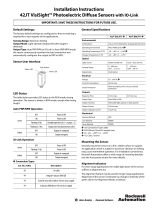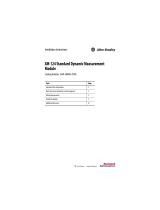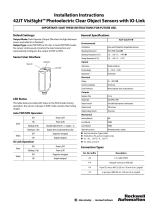Page is loading ...

Installation Instructions
Original Instructions
Analog Laser Sensor
Catalog Numbers
45BPD-8LTB1-D5, 45BPD-8LTB2-D5
Summary of Changes
This manual contains an update to the sensing beam Laser Class. The
Laser Class changed from Class 2 to Class 1.
Description
The 45BPD sensor analog output sensor is a Class 1 visible red laser
sensor that provides sensing with both an analog and discrete output. It
is installed using the Teach-in buttons and status indicators on the top
of the sensor.
This sensor uses the triangulation principle for precise measurement
and the visible red beam spot is useful for alignment in small part
detection and measurement applications. The sensor is self-contained
in an IP67 enclosure and does not require any external control devices,
which add cost and, require additional mounting space.
The 45BPD sensor is easily installed by mounting the sensor so that the
target is within the operating range of the sensor and teach setpoints
that are required for the application. The sensor can be set with both a
discrete PNP output and a 4…20 mA analog output. The discrete
output can be set for normally open (N.O.) or normally closed (N.C.)
operation and the analog output is automatically scaled between the
taught setpoints with either a positive or negative slope.
The 45BPD sensor is an excellent solution for several noncontact
measurement applications including: distance measurement, part
profiling, thickness measurement, error proofing, inspection, verifying
material position, hole depth, warpage, and position.
Specifications
1
For use with any listed (CYLV) cable assembly.
IMPORTANT Save these instructions for future use.
Topic Page
Summary of Changes 1
Description 1
Specifications 1
Features 2
Dimensions 2
Wiring Diagram 2
Sensor Alignment 2
Mounting 3
Wiring 3
Setting the Sensor 4
Accessories 5
Attribute 45BPD-8LTB1-D5, 45BPD-8LTB2-D5
Sensing Beam Visible red Class 1 laser, 650 nm
Sensing Range
45BPD-8LTB1-D5: 30…100 mm (1.18…3.94 in.)
45BPD-8LTB2-D5: 80…300 mm (3.15…11.81 in.)
Range 70 mm and 220 mm (2.75 in. and 8.66 in.)
Spot Size
30/100 mm model
80/300 mm model
1.5 x 3 mm/1.5 x 3.25 mm (0.06 x 0.12 in./ 0.06 x 0.13 in.)
1.5 x 3.5 mm/2.0 x 4.5 mm (0.06 x 0.14 in./ 0.08 x 0.18 in.)
Linearity <0.25% of range
Resolution <0.1% of range
Temperature Drift <0.02%/°C
Supply Voltage 18…30V DC
Current Consumption 40 mA @ 24V DC
Circuitry Protection
Short circuit, overload Figure 3 on page 2
, false pulse, transient
noise, reverse polarity protection
Output Type Discrete: PNP (N.O./N.C.); Analog: Current 4…20 mA
Output Rating 100 mA max. for discrete output, 500 max. impedance for analog
Response Time
Speed Mode: 0.4 ms (applicable with synchronously switched laser
and target
Control Input Laser disable; Teach-in lock; free running
Housing Material Plastic—ABS
Lens Material PMMA
Status indicator Indicators See Figure 3 on page 2
Connection Type 5-pin DC micro, 270° rotatable
Accessories Cordsets, mounting brackets
Operating Environment IP67
Vibration
10…55 Hz, 1.5 mm (0.06 in.) amplitude; 3 planes; meets or
exceeds IEC 60947-5-2
Shock 30 g (1.06 oz); 11 ms; meets or exceeds 60947-5-2
Operating Temperature -10…+60 °C (14…140 °F)
Approvals UL, c-UL-us, and CE marked for all applicable directives
1

2 Rockwell Automation Publication 45BPD-IN001B-EN-P - May 2017
Analog Laser Sensor
Read and understand the Installation Instructions before operating the
sensor. Only qualified personnel can install the 45BPD sensor.
The 45BPD sensor is not a safety component as described by EU
machine directives.
Only mount the analog laser sensor so that it is not directed at people
(head height). And so that the beam path is terminated at the end of its
functional path.
A label has been provided for the user to attach to the sensor during
installation.
Features
• Noncontact measurement
• Visible red Class 1 laser
• Analog and discrete outputs
• Scalable analog output (4…20 mA)
• Configurable discrete output (N.O./N.C.)
•IP67 enclosure
• 270° rotatable connector
• Setpoint adjustment via push buttons
• Self-contained sensor
•Laser-disable control
• Teach-in lockout
• Averaging and speed mode
Dimensions
Dimensions are shown in mm (in.)
Wiring Diagram
The control input (pin 5) can be used to disable the laser by connecting
it to the +DC power supply (18…30V DC). The laser is shut down and
both the discrete and analog outputs retain their state. The control
input (pin 5) can also be used to help prevent setting changes to the
sensor (lockout the Teach-in buttons) by connecting it to 0V DC. The
sensor can be operated in the free-run mode by not connecting the
control input (pin 5).
Sensor Alignment
Position the 45BPD sensor so that the distance from the object to the
sensor is within the sensing range of the sensor.
The sensor can be mounted at an angle of approximately 5° for
reflective targets as shown in Figure 1
.
Figure 1 - Sensor Alignment
Mount the sensor perpendicular to the direction of travel for targets,
which have steps, border lines, and round targets (see Figure 2).
Figure 2 - Mounting Recommendations
The sensor provides more precision when the spot size is not larger
than the feature that is being measured (see Figure 3).
Figure 3 - Special Considerations
50 (1.97)
50
(1.97)
40 (1.57)
44 (1.73)
16 (0.63)
13.5 (0.53)
46
(1.81)
44
(1.73)
17
(0.67)
4.3
(0.17)
4 (0.16)
4 (0.16)
4.3 (0.17)
4 (0.16)
M12 x 1
Allen-Bradley
(1) Brown
(2) White
(3) Blue
(4) Black
(5) Gray
18…30V DC
4…20 mA
0V
Switch output
Control input
5
4
3
1
2
Feature
Size
Spot
Diameter

Rockwell Automation Publication 45BPD-IN001B-EN-P - May 2017 3
Analog Laser Sensor
Mounting
Securely mount the sensor on a firm, stable surface, or support for
better operation. A mounting, which is subjected to excessive vibration
or shift, can cause intermittent operation. The following mounting
brackets are available for installation convenience and sensor
protection. Once securely mounted, the sensor can be wired per the
attached wiring diagrams.
Mounting Bracket Dimensions
Dimensions are shown in mm (in.)
Figure 4 - 45BPD-BKT2
Figure 5 - 45BPD-BKT2
Wiring
The 45BPD sensor is available with a micro quick-disconnect for ease
of installation and maintenance. The connector can be rotated up to
270º to accommodate the installation of the sensor and its associated
wiring. We recommend the use of the 889 Series of cordsets and
patchcords for quick disconnect model sensors. All external wiring
conforms to the National Electric Code and all applicable local codes.
The 45BPD sensor is ready to operate with factory settings after power
is applied.
Possible Settings and Operating Modes
• Set a switching point
• Set a switching window
• Scale the analog output between two setpoints (positive or
negative slope)
• Set the operating mode to either Speed mode or Averaging
mode
• Set the switch type (N.O. or N.C.)
• Reset the sensor to the factory settings
• Laser disable control (requires electrical connection)
• Hold the measured value (requires electrical connection)
• Teach-in button lockout (requires electrical connection)
Status Indicators
Figure 6 - Sensor in Operation
Factory Settings
• Switching Output Q: The switching output is active when the
target is in the operating range.
• Switching Output Q is configured for normally open
operation.
• Analog Output (4…20 mA) Q
A
: 4 mA at the end of operating
range; 20 mA at the beginning of operating range
• Operating mode is set to the Speed mode
Status Indicators
Figure 7 - Teach-in Mode
1
The status indicator can be steady or blinking depending on the Teach-in setting.
48.5 (1.9)
4.3 (0.169)
4.2
(0.165)
10.5 (0.41)
22 (0.86)
24°
4.3 (0.169)
10.5
(0.41)
50°
30
(1.18)
50.97
(2.0)
4.3
(0.169)
2
(0.07)
21.2
(0.83)
13.9
(0.54)
58
(2.28)
4.3
(0.169)
24°
4.3 (0.169)
14.85 (0.58)
17
(0.66)
23.8
(0.93)
7 x M4
38.2 (1.5)
8.5
(0.33)
65 (2.55)
O in operating mode
Sensor detects target within operating
range with sucient margin
(Green)
QA status
Target is between 0…100% set points
(Yellow)
Q output congured
normally closed
(Green)
Sensor operating in
averaging mode
(Green)
Q output is active
(Yellow)
Power
(Steady Green)
O in
operating mode
N
SET
Q
QA
QA
OK
OK
R
A
NN
SET
Q
QAQA
OKOK
R
A
N
SET
Q
QAQA
OKOK
R
A
N
SET
Q
QAQA
OKOK
R
A
N
SET
Q
QAQA
OKOK
R
A
Sensor can be reset
to factory settings
(Green)
Sensor detects target within
operating range with sucient
margin (Green)
QA output can be set
(Yellow)
Q output conguration
can be set (N.O./N.C.)
(Green)
Averaging mode
function can be set
(Green)
Q output can be set
(Yellow)
Power/Teach-in
(Blinking Green)
Status indicator
(Red )
SET button for
Teach-in mode
Scroll button advances to the
next function in Teach-in mode
1

4 Rockwell Automation Publication 45BPD-IN001B-EN-P - May 2017
Analog Laser Sensor
Setting the Sensor
The 45BPD sensor is installed using the push buttons (SET and )
and the status indicator on the top of the sensor.
To begin the Teach-in process, press the SET and
and buttons
simultaneously for three seconds. The Power/Teach-in status indicator
begins to blink when the sensor is in the Teach-in mode.
Scroll through the Teach-in functions is done using the button and is
indicated as shown in Figure 7. There are five possible settings (Q, Q
A
,
Av, Nc, R). To skip over a function and not change a setting, press the
button to advance to the next desired function. After the last
function is reached, the menu is started again from the first function.
Press the SET button to teach the selected function that is indicated by
the Teach-in status indicators.
Step 1—Setting the Discrete Output Q
The discrete output can be set with either a switchpoint or switching
window as described.
Switchpoint
Press the button until the “Q” status indicator turns on which shows
that this function can be set.
Position the target at the desired switchpoint.
Press the SET button and the status indicator begins to blink, which
sets the switchpoint.
Press the
button to advance to the next setting or press the SET and
and buttons simultaneously for 1 second to exit the Teach-in
process.
Switching Window
Press the button until the “Q” status indicator turns on which
specifies that this function can be set.
Position the target at the first limit for the switching window.
Press the SET button and the status indicator begins to blink, which
sets the first limit.
Position the target at the second limit for the switching window.
Press the SET button and the status indicator turns on as long as SET is
pressed to confirm, which sets the second limit.
Press the
button to advance to the next setting or press the SET and
and buttons simultaneously for 1 second to exit the Teach-in
process.
Step 2—Scaling the Analog Output Q
A
Press the button until the “Q
A
” status indicator turns ON, which
shows that this function, can be set.
Position the target at the desired 0% point (4 mA).
Press the SET button and the status indicator begins to blink, which
sets the 0% setpoint.
Position the target at the desired 100% point (20 mA).
Press the SET button and the status indicator turns on as long as SET is
pressed to confirm, which sets the 100% setpoint.
Press the
button to advance to the next setting or press the SET and
and buttons simultaneously for 1 second to exit the Teach-in
process.
Figure 8 - Analog Output
Step 3—Setting the Averaging Mode/ Speed Mode
Press the button until the “Av” status indicator turns on which shows
that this function can be set.
This function can be set to either Averaging mode or Speed mode by
pressing the SET button.
The status indicator turns on when the Averaging mode is active, the
status indicator turns off when operating in the Speed mode.
Press the
button to advance to the next setting or press the SET and
and buttons simultaneously for 1 second to exit the Teach-in
process.
IMPORTANT If the target is in the same position when setting both limits
of the switching window, a minimum switching window of
1% of the operating range is set around the teach point.
IMPORTANT If the distance between the 0% and 100% setpoints is less
than 5% of the overall operating range, then the analog
output is automatically scaled to 5% of the operating range.
The middle is placed between the 0% and 100% setpoints.
20
4
0% Set Point 100% Set Point
Target position
Analog Current (mA)
20
4
0% Set Point100% Set Point
Target position
Analog Current (mA)

Rockwell Automation Publication 45BPD-IN001B-EN-P - May 2017 5
Analog Laser Sensor
Figure 9 - Average/Speed Mode
Step 4—Discrete Output Configuration (N.O. / N.C.)
Press the button until the “Nc” status indicator turns on which
shows that this function can be set.
This function can be set to either Normally Open mode or Normally
Closed mode by pressing the SET button.
The status indicator turns on when the output is in the normally closed
mode, the status indicator turns off when the output is in the normally
open mode.
Press the button to advance to the next setting or press the SET and
and buttons simultaneously for 1 second to exit the Teach-in
process.
Step 5—Factory Reset
Press the button until the “R” status indicator turns ON, which
shows that this function, can be set.
The sensor can be reset to the factory settings by pressing the SET
button.
The status indicator turns on as long as the SET button is depressed to
confirm that the sensor has been reset.
Press the
button to advance to the next setting or press the SET and
and buttons simultaneously for 1 second to exit the Teach-in
process.
Exit the Teach-in Menu
After the desired functions are set, press SET and simultaneously for
approximately 1 second to save the settings and exit the Teach-in mode.
The sensor begins normal operation mode, which is based on these
Teach-in settings.
Accessories
Micron Conversions
Application Notes
1. The sensor can be powered for approximately 5 minutes for
maximum precision.
2. The sensor is ready to operate after a delay (300 ms).
3. The precision of the sensor is dependent on the combined
errors of linearity, resolution, and temperature drift.
IMPORTANT The averaging mode can be used when detecting rough
surfaces. The speed mode can be used when the shortest
response time and maximum switching frequency is required.
Speed Mode
Average Mode (100 measured valves)
Response
I(mA)
Direction of movement
Time(s)
Description Cat. No.
2 m (6.5 ft) Micro QD
Cordset
889D-F5AC-2
Mounting Bracket 45BPD-BKT1 —
Protective Mounting
Bracket
45BPD-BKT2 —
1 m = 0.001 mm
1 m = 0.000039 in.
25.4 m = 0.001 in. (one thousandth)
20 m = 0.00079 in. (0.79 thousandths)

6 Rockwell Automation Publication 45BPD-IN001B-EN-P - May 2017
Analog Laser Sensor
Notes:

Rockwell Automation Publication 45BPD-IN001B-EN-P - May 2017 7
Analog Laser Sensor
Notes:

Allen-Bradley, Rockwell Automation, and Rockwell Software are trademarks of Rockwell Automation, Inc.
Trademarks not belonging to Rockwell Automation are property of their respective companies.
Rockwell Otomasyon Ticaret A.Ş., Kar Plaza İş Merkezi E Blok Kat:6 34752 İçerenköy, İstanbul, Tel: +90 (216) 5698400
Rockwell Automation maintains current product environmental information on its website at
http://www.rockwellautomation.com/rockwellautomation/about-us/sustainability-ethics/product-environmental-compliance.page
.
Publication 45BPD-IN001B-EN-P - May 2017 75009-266-01 Ver 03
Supersedes Publication 45BPD-IN001A-EN-P - March 2006 068-13806
Copyright © 2017 Rockwell Automation, Inc. All rights reserved. Printed in the U.S.A.
Rockwell Automation Support
Use the following resources to access support information.
Documentation Feedback
Your comments will help us serve your documentation needs better. If you have any suggestions on how to improve this document, complete the
How Are We Doing? form at http://literature.rockwellautomation.com/idc/groups/literature/documents/du/ra-du002_-en-e.pdf
.
Technical Support Center
Knowledgebase Articles, How-to Videos, FAQs, Chat, User
Forums, and Product Notification Updates.
https://rockwellautomation.custhelp.com/
Local Technical Support Phone Numbers Locate the phone number for your country. http://www.rockwellautomation.com/global/support/get-support-now.page
Direct Dial Codes
Find the Direct Dial Code for your product. Use the code to
route your call directly to a technical support engineer.
http://www.rockwellautomation.com/global/support/direct-dial.page
Literature Library
Installation Instructions, Manuals, Brochures, and
Technical Data.
http://www.rockwellautomation.com/global/literature-library/overview.page
Product Compatibility and Download
Center (PCDC)
Get help determining how products interact, check
features and capabilities, and find associated firmware.
http://www.rockwellautomation.com/global/support/pcdc.page
/







